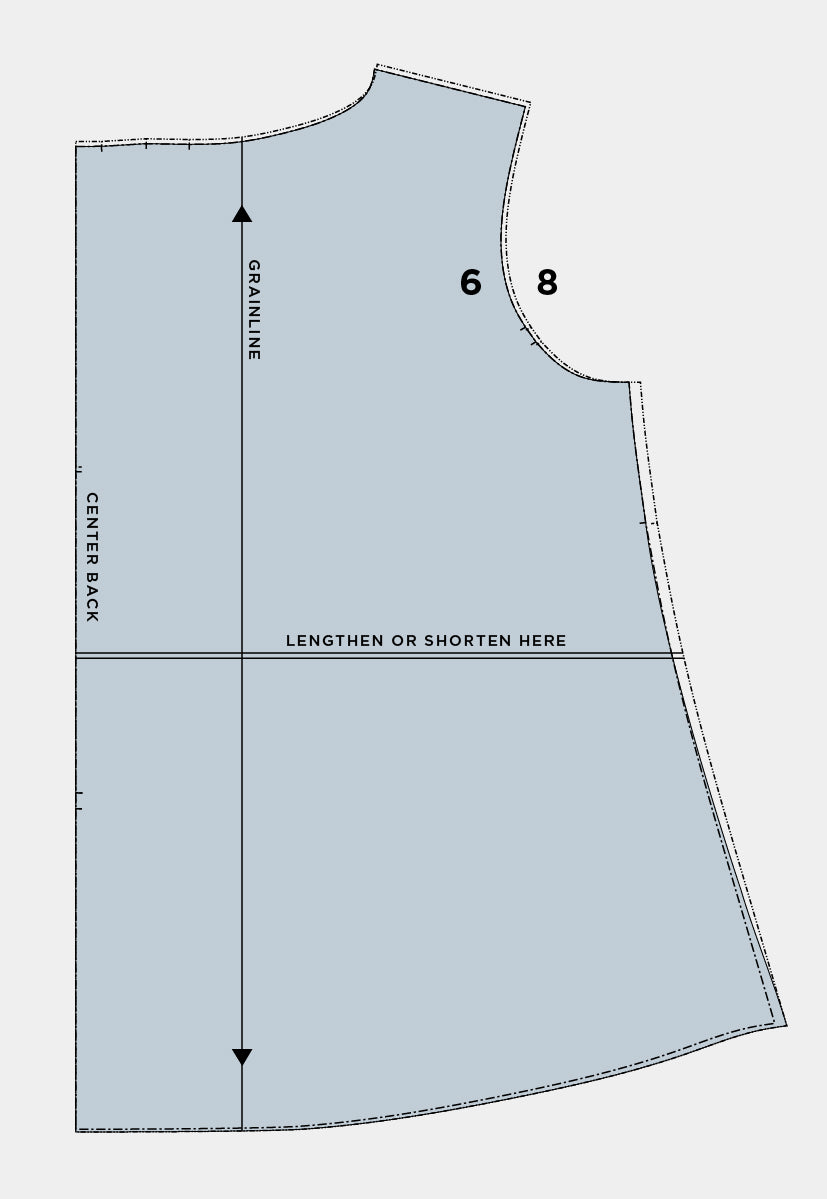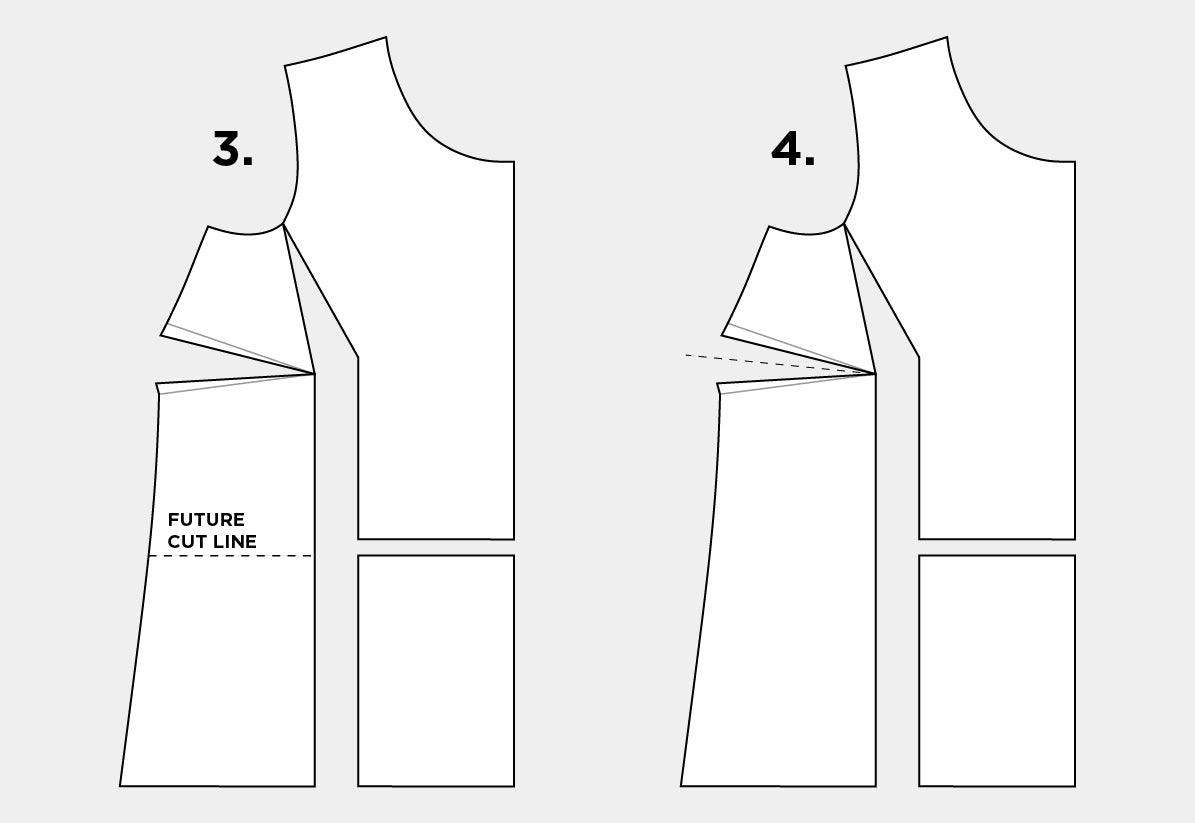Today we're going to talk about a few common pattern adjustments you might find helpful in making your Hadley Top. Below you'll find instructions for lengthening and shortening your Hadley, how to blend between sizes, moving the dart, and completing a full bust adjustment. Let's start with the easiest first, blending between sizes.
Blending Between Sizes

In the above example we're blending between a 6 at the bust and an 8 at the hip. As we mentioned in the previous post on choosing your size, we recommend focusing on these two measurements as the A-line shape of the top negates the waist measurement in the majority of people. To go between sizes you'll want to blend between the bust and hip, rather than from the bust to the hip, because you don't want to affect the measurements at those points, just the space between them. If you need to blend between sizes as well as do other adjustments, we recommend that you blend first. Make sure you apply any changes you make to all affected pieces. In this case you would want to do the same to the back of the top.
Lengthening and Shortening

Lengthening and shortening your pieces is pretty straightforward. You'll want to find the lengthen/shorten lines and apply your changes between them.
- Start by locating the pattern piece you need to adjust, in this example I'm showing the front bodice but the same applies to the back or sleeve.
- Cut between the lengthen / shorten lines marked on the pattern. With a piece of paper underneath the pattern, spread the two sections the amount you need to lengthen your piece, making sure to keep the grain line of the two pieces aligned.
- Trace your piece off onto the paper and re-blend any gagged edges along the side seam. Repeat the adjustment to any other affected pieces.
If you're shortening the same steps apply only rather than spreading the pieces apart, you'll be overlapping them the amount you need to shorten the pattern.
Moving the Dart


- If you find that the torso is the correct length but you need to move the dart, here are some easy steps to do so. We're going to be moving the dart up in this tutorial, but if you need to lower it just do the opposite.
- Draw a line through the bust point parallel to the CF/grain line. Place a mark along that line at the point where you need to lower the dart. If you need to raise the dart 1" you would place the mark 1" above the existing bust point.
- Move the dart legs up that same amount from where they meet with the side seams. Reconnect the dart legs to the dart point.
- You're going to now need to re-fold the dart. Since you've moved it the dart take-up is now in the wrong place and shape at the side seam. Fold the dart so that the dart excess points down towards the waist and re-blend the side seam. Trim off the excess.
- This is your new pattern.
Full Bust Adjustments
Now lets talk full bust adjustments. The Hadley is drafted for a B cup like the rest of our patterns, so if you're a C you may be able to get away without a FBA. The illustrations are cropped for better detail, but any vertical lines should extend to the bottom of the pattern piece. If you'd like to do a small bust adjustment you would do the opposite of what I'm showing here.
The first thing you need to do before you start your full bust adjustment is to figure out how much of an adjustment you'll need. To begin, you'll need your upper bust measurement and your full bust measurement. Once you have those you'll subtract your upper bust from your full bust. If the number you get when you subtract your upper bust from your full bust (the total adjustment) is over 2" (B cup) you may need a full bust adjustment, whereas if the number you get is 2" of less you're either fine to use the pattern as is, or you might consider a small bust adjustment. So if your full bust was 40" and your upper bust was 36" you'd subtract 40-36 to get 4" which would require an adjustment.
Now you can take this new number and do one of two things with it. It seems to be the most common to just divide this number in half and apply that number to each side of the adjustment shown below, so you would move the pattern 2" in Step 3.
Your other option is to take your new number, in our case 4" and subtract 2" from it to get the full amount of your bust adjustment. Subtracting the 2" comes from the fact that the pattern is drafted for a B cup which is already a 2" difference. Since this amount is already drafted into the pattern you are just adding the additional amount on top of what exists. You would then divide the full amount of the adjustment in half so you would be doing a 1" adjustment on each side of the pattern. We recommend doing a muslin to decide which method works best for your body.



- Select your size based on your upper bust & waist measurements. Cut size.
- Locate the apex of your bust and mark. Draw a line from the apex out to the side seam. Next you're going to draw a vertical line from the apex down to the hemline of the pattern piece, making sure to keep the line parallel to the CF/grain line. From there draw a line connecting the apex to the approximate center of the armscye. These are the lines that will form the full bust adjustment. Additionally you're going to need a line across the torso, perpendicular to the CF/grain line in order to line up the hem in a future step. I made this one dotted so it doesn't get confused with the adjustment lines.
- Slash through the waistline to the bust and up to the armscye taking care to cut to, but not through, the pattern at that point. You want to make sure that the two pieces are hinged together. Then slice through the line connecting the side seam to the apex, taking care to not cut through the apex point. You want the pieces hinged. You'll then open the vertical slit the amount of your full bust adjustment making sure that the two edges of the opening are parallel.
- You'll notice that when you move the side out for the adjustment the side panel becomes longer than the piece you moved. Cut along the line you drew in Step 2 and align the newly freed piece so that it's even with both the center front and the dotted line on the side piece.
- This method of adjustment will result in a larger dart being formed. To aide in creating the expanded dart, find the center of the dart legs and mark a line through the center of the dart (dotted line above). This will help you when folding the dart in the next step.
- Fold the dart legs together with the takeup pointing towards the bottom of the garment and re-blend the side seam. I like to score the bottom dart leg and center line lightly with an awl to help the pattern fold exactly where you want it to on the first try. You can either cut across the side seam/dart or mark it with a pattern tracing wheel and cut when the dart is open.
- Unfold the dart and cut out your new piece.
That's all for adjustments...almost time to start sewing!











